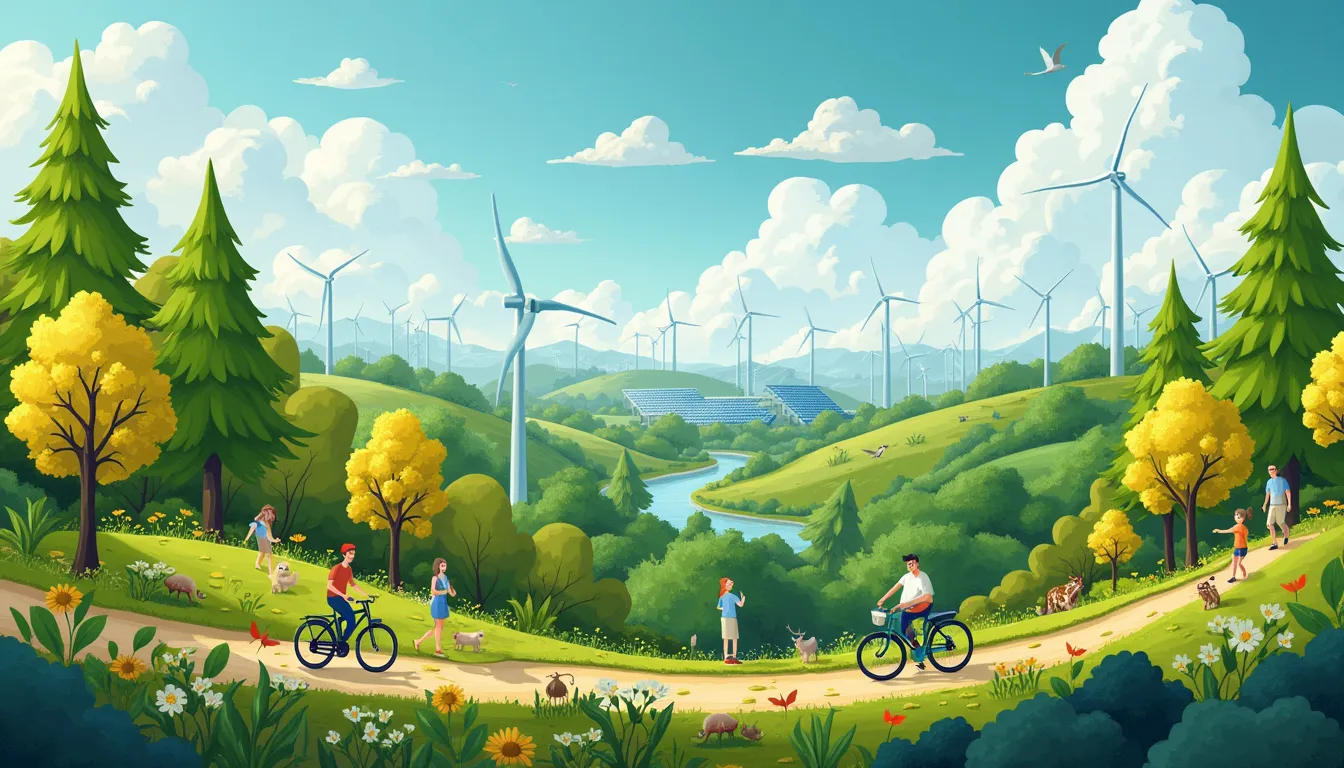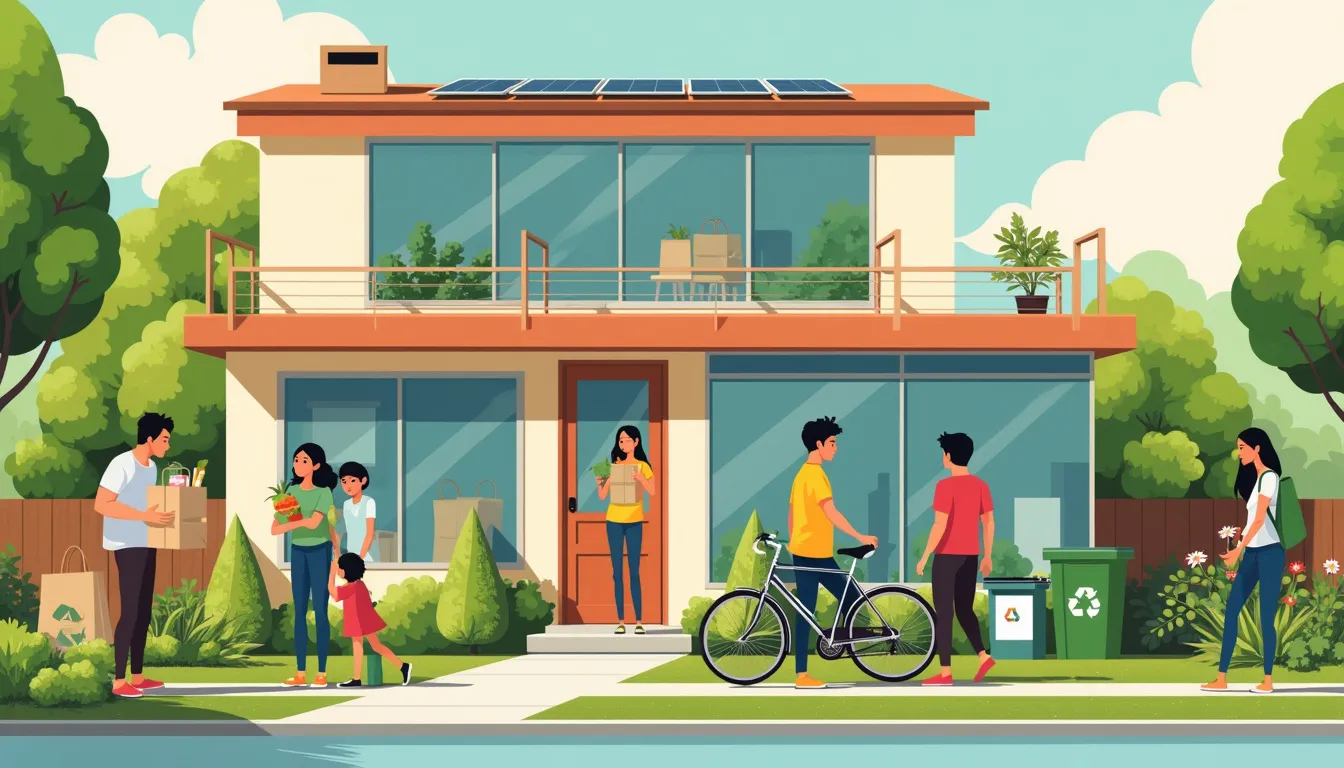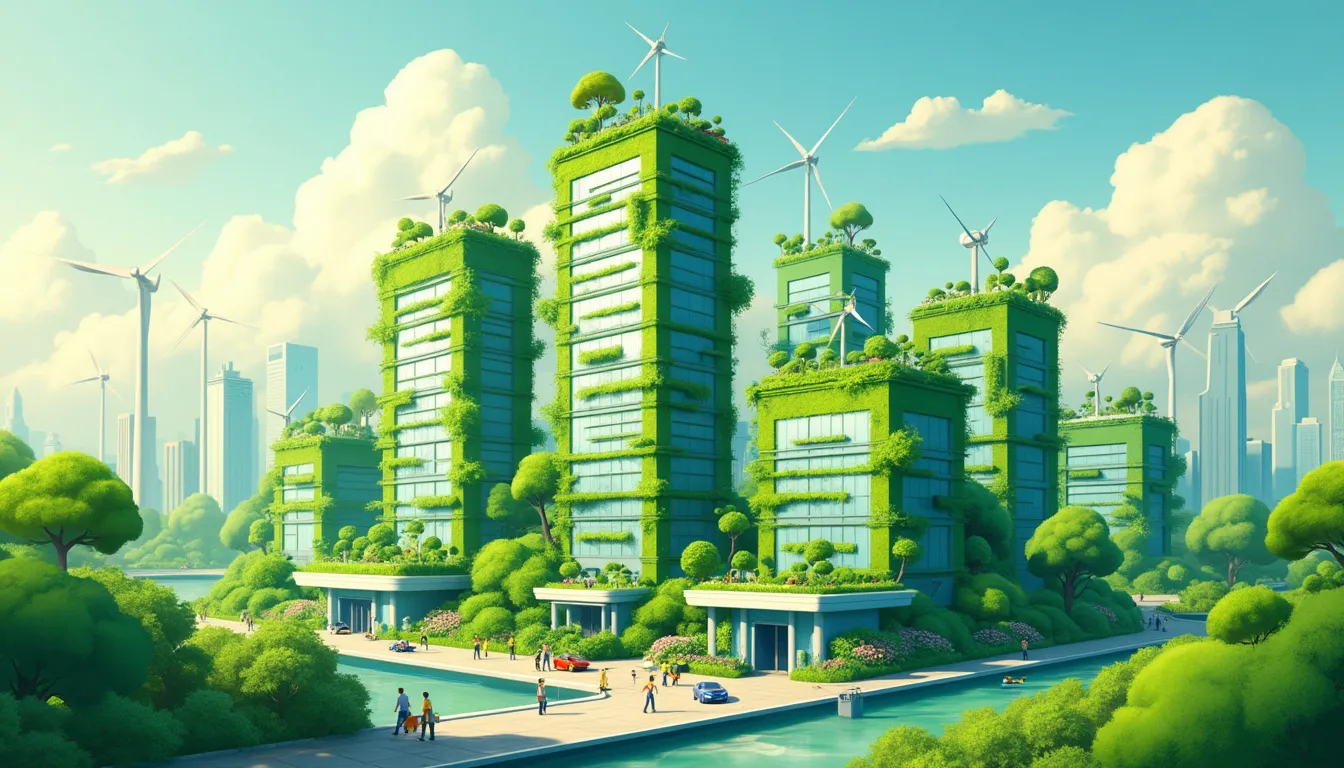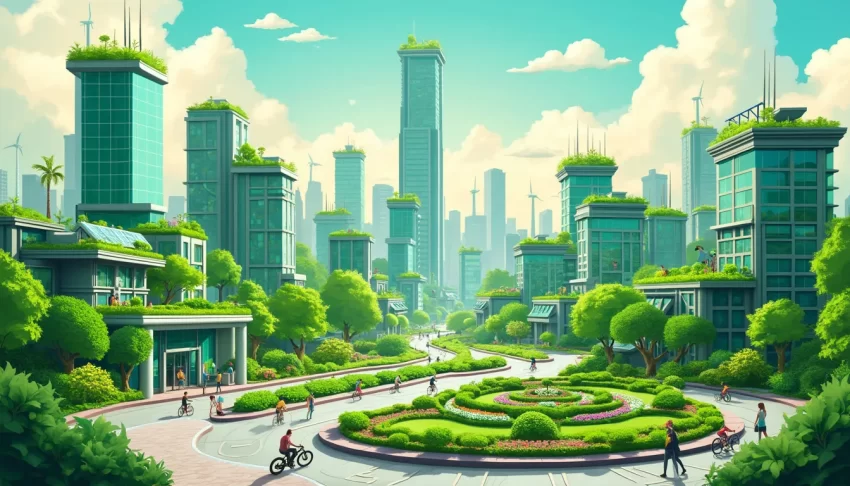In an era where climate change, resource depletion, and biodiversity loss dominate the headlines, the concept of sustainability has never been more crucial. As we navigate the 21st century, the urgent need to adopt sustainable practices permeates every aspect of our lives, from how we live and work to how we grow our economies and protect our planet. Sustainability isn’t just a buzzword; it’s a comprehensive approach to ensuring that our actions today do not compromise the ability of future generations to meet their own needs. This multifaceted approach encompasses environmental stewardship, economic resilience, and social well-being.
Every day, we witness the undeniable impacts of global environmental challenges. Rising sea levels, extreme weather events, and the loss of vital ecosystems are stark reminders that our current way of life is unsustainable. But amid these challenges lies a profound opportunity—an opportunity for individuals and businesses alike to play a pivotal role in reversing these trends. Embracing sustainability goes beyond mere corporate social responsibility or individual eco-friendly choices. It represents a collective commitment to a better future, one where economic growth and environmental health go hand in hand, fostering communities that thrive both socially and economically.
At its core, sustainability asks us to rethink our habits and innovate our approach to production and consumption. Whether it’s adopting renewable energy, reducing waste, or supporting sustainable supply chains, these steps not only help reduce our environmental footprint but also bring substantial economic and social benefits. From long-term cost savings and job creation in the burgeoning green economy to enhanced community health and improved quality of life, the advantages of sustainable practices are vast and far-reaching.
As we embark on this journey toward a greener future, this article will explore the essential aspects of sustainability. We’ll delve into the myriad benefits of embracing sustainable practices, provide practical steps that individuals and businesses can take, and look ahead to the promising future of sustainability driven by emerging trends and technologies. Together, we can pave the way for a world that values and preserves its resources, ensuring a prosperous, healthy, and vibrant future for all.
Introduction to Sustainability
Definition and Importance of Sustainability
Sustainability is more than just a buzzword; it’s about meeting our current needs without compromising the ability of future generations to meet theirs. At its core, sustainability involves a balanced approach to ecological health, economic prosperity, and social well-being. According to the United Nations’ Brundtland Commission Report, sustainable development seeks to harmonize human activities with the Earth’s natural systems while fostering economic growth and social equity.
Why is sustainability important? Simply put, Earth’s resources are finite. As populations grow and consumption increases, the strain on our planet intensifies. Embracing sustainability ensures that we use resources more efficiently, minimize waste, and protect our ecosystems, which in turn supports healthier, more resilient communities.
Overview of Global Environmental Challenges
To truly grasp the importance of sustainability, it’s essential to understand the pressing environmental challenges we face globally. Climate change is arguably the most significant threat, characterized by rising temperatures, melting ice caps, and more frequent and severe weather events. According to NASA, 2020 tied with 2016 as the warmest year on record, highlighting the urgent need for climate action.
Deforestation and biodiversity loss are other critical issues, with the World Wildlife Fund reporting that the planet has lost 68% of global wildlife populations since 1970. The destruction of natural habitats not only drives species to extinction but also undermines ecosystem services that humans depend on, such as clean air, water, and pollination.
Pollution, both of our air and water, presents further challenges. The World Health Organization estimates that air pollution causes about 7 million premature deaths every year. Plastics and other contaminants in our oceans are another concern, with about 8 million metric tons of plastic entering the ocean each year, according to the Ocean Conservancy. These pollutants threaten marine life and, ultimately, human health through the food chain.
The Role of Individuals and Businesses in Promoting Sustainability
Both individuals and businesses play crucial roles in fostering sustainability. Our personal choices, from the products we buy to the energy we consume, collectively have a significant environmental impact. Simple decisions, like reducing waste, recycling, and choosing sustainable products, can add up to meaningful change.
For example, consider the powerful effect of a family deciding to cut their plastic use. By opting for reusable bags, bottles, and containers, they can significantly reduce the volume of plastic waste they generate, contributing to a decrease in overall plastic pollution. Moreover, choosing energy-efficient appliances and reducing energy consumption at home can not only lower utility bills but also reduce greenhouse gas emissions.
Businesses, on the other hand, have the leverage and resources to drive significant sustainability initiatives. Through sustainable supply chains, energy-efficient operations, and green product innovations, businesses can reduce their carbon footprints and set industry standards for environmental stewardship. Companies like Patagonia and Tesla are exemplary in integrating sustainability into their core operations, influencing market trends towards eco-friendliness.
One inspiring story comes from Unilever, which has committed to ensuring that all its plastic packaging will be fully reusable, recyclable, or compostable by 2025. This ambitious goal demonstrates how large corporations can take responsibility and drive forward-looking initiatives that benefit the environment.
In summary, sustainability is a collective effort. Individuals have the power to drive change through everyday actions, while businesses have the capacity to innovate and lead substantial initiatives. By understanding the concept of sustainability and recognizing the urgent environmental challenges, we can all play a part in preserving our planet for future generations.

Benefits of Embracing Sustainability
Environmental Benefits: Reducing Carbon Footprint, Conservation of Resources
Embracing sustainability has profound environmental benefits that reach far beyond what meets the eye. One of the most significant advantages is the reduction of our carbon footprint. Our daily activities, from driving cars to powering homes, contribute to the increase of greenhouse gases in the atmosphere, intensifying global warming. By adopting sustainable practices, such as using renewable energy sources like solar and wind power, we can significantly cut down these emissions. According to the Environmental Protection Agency (EPA), renewable energy can reduce emissions of carbon dioxide and other pollutants by up to 90% compared to fossil fuels.
Resource conservation is another critical aspect. Natural resources, including water, minerals, and forests, are being depleted at alarming rates. The World Wildlife Fund (WWF) reports that we are using 1.75 times the Earth’s capacity to regenerate these resources. Simple changes, such as reducing water usage, opting for sustainably sourced products, and supporting reforestation initiatives, help conserve these precious resources for future generations.
Economic Benefits: Long-term Cost Savings, Growth Opportunities in Green Economy
Sustainability isn’t just good for the planet—it’s a savvy economic move as well. Many people and businesses worry about the upfront costs of implementing sustainable practices, but the long-term savings often outweigh these initial investments. For instance, energy-efficient appliances and lighting can reduce household energy bills by up to 30%, according to the U.S. Department of Energy. Similarly, businesses can save substantial amounts by optimizing resource use, reducing waste, and improving energy efficiency.
Moreover, the green economy is burgeoning with opportunities. As global awareness of environmental issues increases, demand for sustainable products and services is on the rise. This shift opens doors for innovation and entrepreneurship. Companies that lead in sustainability are not only fostering positive change but are also positioning themselves ahead in a competitive market. According to a report by the International Labour Organization (ILO), the green economy could create 24 million new jobs globally by 2030, particularly in sectors like renewable energy, construction, and waste management.
Social Benefits: Enhanced Quality of Life, Healthier Communities
Sustainability greatly enhances the quality of life and builds healthier communities, which might be the most compelling reason for its adoption. For starters, reducing pollution through sustainable practices leads to cleaner air and water, which directly impacts public health. The World Health Organization (WHO) estimates that air pollution is responsible for seven million premature deaths annually. By cutting down on pollutants, we can create a healthier environment for everyone.
Additionally, sustainable practices foster community well-being and social equity. Initiatives like urban gardening, community recycling programs, and local farmers’ markets not only reduce environmental footprint but also bring people together, fostering a sense of community and shared responsibility. These activities promote social inclusion and empower communities, making them more resilient to environmental and economic challenges.
Even on a more personal level, embracing sustainability can enhance life satisfaction. Knowing you are contributing positively to the planet and future generations brings a sense of purpose and fulfillment. Simple acts, such as composting kitchen waste or biking to work, can make a big difference and encourage a more mindful way of living.
In essence, the benefits of embracing sustainability are profound and far-reaching. From safeguarding our planet to boosting the economy and enhancing our quality of life, the shift towards sustainability holds tremendous promise. It’s a path that not only leads to a greener future but a brighter, healthier, and wealthier one as well. By understanding and appreciating these benefits, we can all become advocates for change and play our part in promoting a sustainable world.

Practical Steps Toward Sustainability
Adopting Sustainable Practices in Daily Life
Sustainability begins at home and within our daily routines. One of the most impactful steps we can take is to reduce waste. In the United States alone, approximately 200 million tons of waste are produced annually. To combat this, start by embracing practices like composting organic waste and reducing single-use plastic consumption. Consider replacing disposable items with reusable ones, such as stainless steel water bottles and cloth shopping bags.
Recycling is another crucial component. While recycling rates have improved, with about 32% of waste being recycled, there’s still ample room for improvement. Make it a habit to separate recyclables from your trash. Check local guidelines to understand what can and cannot be recycled in your area.
Energy efficiency at home can also make a significant impact. Simple measures such as switching to LED bulbs, using energy-efficient appliances, and unplugging devices when not in use can reduce energy consumption. Insulating your home and using programmable thermostats can further reduce your carbon footprint and save on utility bills.
Water conservation is another practical step. Fixing leaks, installing water-efficient fixtures, and collecting rainwater for gardening are effective ways to conserve this precious resource.
Businesses Leading the Way: Sustainable Supply Chains, Green Innovation
Businesses play a pivotal role in driving sustainability. One key area is developing sustainable supply chains. This encompasses everything from sourcing eco-friendly materials to ensuring fair labor practices. Companies like Patagonia have set inspiring examples by prioritizing sustainability in their operations. Their commitment to using 100% renewable energy in their supply chain and focusing on sustainable sourcing has set a benchmark in the industry.
Green innovation is another area where businesses can make a substantial impact. This involves designing products and services that minimize environmental harm. Tesla, for instance, has revolutionized the automotive industry with its electric vehicles (EVs). The rise of EVs demonstrates how sustainable products can meet consumer needs while significantly reducing carbon emissions.
Eco-friendly packaging is a growing trend among businesses. Brands like Lush are pioneers in using minimal, recyclable, and biodegradable packaging, proving that it’s possible to deliver high-quality products without compromising the environment.
Moreover, many companies are adopting circular economy practices, which focus on reusing and recycling products. IKEA’s furniture take-back program illustrates this concept, offering customers incentives to return old furniture for recycling or refurbishment.
Government Policies and Incentives for Sustainable Development
Governments worldwide are implementing various policies and incentives to promote sustainability. These government actions play a crucial role in fostering an environment where both individuals and businesses can thrive sustainably.
In recent years, policies such as carbon pricing, renewable energy incentives, and stringent emission regulations have become more common. Carbon pricing, for instance, puts a monetary value on carbon emissions, incentivizing businesses to reduce their carbon footprint. Countries like Sweden have successfully implemented carbon taxes, leading to a significant reduction in greenhouse gas emissions.
Renewable energy incentives are another powerful tool. In the United States, the federal government offers tax credits for solar panel installations, encouraging both residential and commercial properties to adopt renewable energy sources. As a result, solar energy installations have skyrocketed, contributing to a cleaner energy grid.
Other examples include subsidies and grants for sustainable farming practices. The European Union’s Common Agricultural Policy (CAP) provides financial assistance to farmers who adopt environmentally friendly practices, such as crop rotation and organic farming.
Urban planning policies also play a significant role. Cities like Copenhagen have invested heavily in bike-friendly infrastructure and public transportation, significantly reducing car dependency and improving air quality.
Additionally, building codes promoting energy efficiency are becoming more stringent. In California, the Title 24 Building Energy Efficiency Standards are designed to reduce energy consumption in new and existing buildings. These regulations ensure that buildings are more energy-efficient, reducing the overall demand for electricity and thereby decreasing emissions from power plants.
Governments are also fostering public-private partnerships to drive sustainable innovation. The UK’s Green Investment Bank, for example, collaborates with private investors to fund a variety of green projects, from renewable energy to energy efficiency improvements.
As you can see, the move towards sustainability is multifaceted, requiring concerted efforts from individuals, businesses, and governments alike. By adopting practical sustainable practices in our daily lives, encouraging businesses to champion eco-friendly innovations, and supporting government policies that drive sustainable development, we can collectively orchestrate a shift towards a greener, more sustainable future. Embrace these steps today, and be part of the change that our planet urgently needs.

Future of Sustainability
Emerging Trends and Technologies in Sustainability
The future of sustainability is marked by innovation and adaptive approaches to mitigate environmental impacts. One of the most promising trends is the rise of renewable energy sources like solar, wind, and hydro power. These alternatives to fossil fuels not only reduce greenhouse gas emissions but also promote energy independence and security. For instance, the cost of solar photovoltaic panels has decreased significantly over the past decade, making it more accessible to both households and businesses.
Another key development is the advancement in electric vehicles (EVs). With major automakers committing to phase out internal combustion engines, EVs are fast becoming a mainstream choice. Innovations in battery technology are enhancing the range and reducing the cost of these vehicles, thus encouraging wider adoption. Tesla, for example, continues to push boundaries, not just in the automotive space but also with its solar and energy storage solutions.
Smart technology also plays a critical role in sustainability. The Internet of Things (IoT) is enabling more efficient management of resources through smart grids, smart homes, and precision agriculture. These technologies allow for real-time monitoring and data-driven decision-making, which can lead to significant reductions in resource consumption and waste.
Case Studies of Successful Sustainability Initiatives
Real-world examples of sustainable practices offer valuable lessons and inspiration for both individuals and businesses. One such case is Patagonia, the outdoor clothing company renowned for its environmental ethos. Patagonia has implemented a robust recycling program, turning old garments into new products. They also engage in transparent supply chain practices and invest a portion of their profits into environmental causes. Their recent ‘Worn Wear’ initiative encourages customers to trade in used Patagonia clothing, which is then resold, thereby promoting a circular economy.
Another noteworthy example is Unilever. This consumer goods giant has set ambitious sustainability goals through its ‘Sustainable Living Plan,’ aiming to improve the health and well-being of more than 1 billion people and halve its environmental footprint by 2030. Unilever’s efforts include sourcing 100% of its agricultural raw materials sustainably and reducing waste across its product lifecycle. These initiatives not only foster environmental stewardship but also resonate with increasingly eco-conscious consumers.
In the tech world, Google has been a leader in renewable energy procurement, achieving 100% renewable energy for its global operations since 2017. Through power purchase agreements (PPAs), Google invests in wind and solar projects, actively contributing to the green energy market. Additionally, the company’s data centers utilize advanced cooling techniques and AI-driven operational efficiencies to minimize energy use.
Vision for a Sustainable Future and How to Get There
Envisioning a truly sustainable future involves a holistic approach that integrates social, economic, and environmental well-being. This vision includes cities powered by clean energy, zero-waste economies, abundant green spaces, and resilient communities. To realize this future, various stakeholders must collaborate and embrace systemic changes.
Individuals can start by making conscious choices in their daily lives. Simple actions such as reducing meat consumption, opting for public transport, and minimizing single-use plastics can collectively make a substantial impact. Additionally, becoming more informed and involved in sustainability efforts, whether through local community initiatives or global movements like Earth Day, fosters a culture of environmental responsibility.
For businesses, adopting a sustainable business model is imperative. This involves not only minimizing negative environmental impacts but also actively contributing to societal good. Companies can invest in sustainable innovations, practice ethical sourcing, and create products designed for end-of-life recyclability. Engaging in carbon offset programs and adopting circular economy principles can further drive positive change.
Governments play a pivotal role by enacting policies that incentivize sustainability. Tax credits, subsidies for renewable energy projects, stringent environmental regulations, and funding for green research and development all serve to promote a sustainable economy. Public-private partnerships can facilitate the development of infrastructure needed for a low-carbon future, while international cooperation ensures that climate action efforts are concerted and effective.
Ultimately, the journey towards a sustainable future is a collaborative effort. By fostering innovation, sharing knowledge, and committing to sustainability goals, a greener, healthier world is within our reach. Each step taken by individuals, businesses, and governments brings us closer to this vision, making sustainability not just a necessity, but an achievable and inspiring reality.
As we wrap up our exploration of how embracing sustainability can lead us toward a greener future, it’s crucial to recognize that this journey is both vital and attainable. The path to sustainability is paved with opportunities for meaningful change, offering profound benefits not just for the planet, but also for our economies and our communities.
Understanding sustainability and acknowledging the global environmental challenges we face is the first step. The urgency cannot be overstated — climate change, resource depletion, and pollution are pressing issues that call for immediate action. The responsibility lies with each of us, as individuals and as businesses, to adopt practices that promote sustainability.
The benefits of these efforts are clear and compelling. On an environmental level, adopting sustainable practices reduces our carbon footprint and conserves precious resources. Economically, it opens doors to cost savings and new opportunities within the green economy. Socially, it fosters a higher quality of life and healthier communities for all.
Incorporating sustainability into our daily lives doesn’t require radical changes; simple steps like reducing waste, recycling, and enhancing energy efficiency can make a significant impact. For businesses, creating sustainable supply chains and investing in green innovations not only improves environmental outcomes but also drives long-term profitability and market competitiveness. Governments too play a pivotal role by implementing policies and incentives that encourage sustainable development.
Looking ahead, the future of sustainability is promising, driven by emerging trends and technologies. Inspiring case studies demonstrate that success is possible and provide a blueprint for others to follow. From renewable energy advancements to sustainable agriculture practices, innovations are continuously reshaping what’s possible.
Our vision for a sustainable future is one where environmental stewardship, economic resilience, and social well-being are seamlessly integrated. Achieving this vision requires a collective effort, where every small action contributes to a larger impact. By committing to sustainable practices today, whether in our homes or our businesses, we’re not just preserving the environment for future generations — we’re actively building a world where everyone can thrive.
So, let’s take these insights and put them into practice. Embrace sustainability not as a daunting challenge, but as a path to a brighter, more resilient future. Your efforts, no matter how small, make a difference. Together, we can create a greener, more sustainable world.
Support Us: Check out our recommended products on Amazon.

